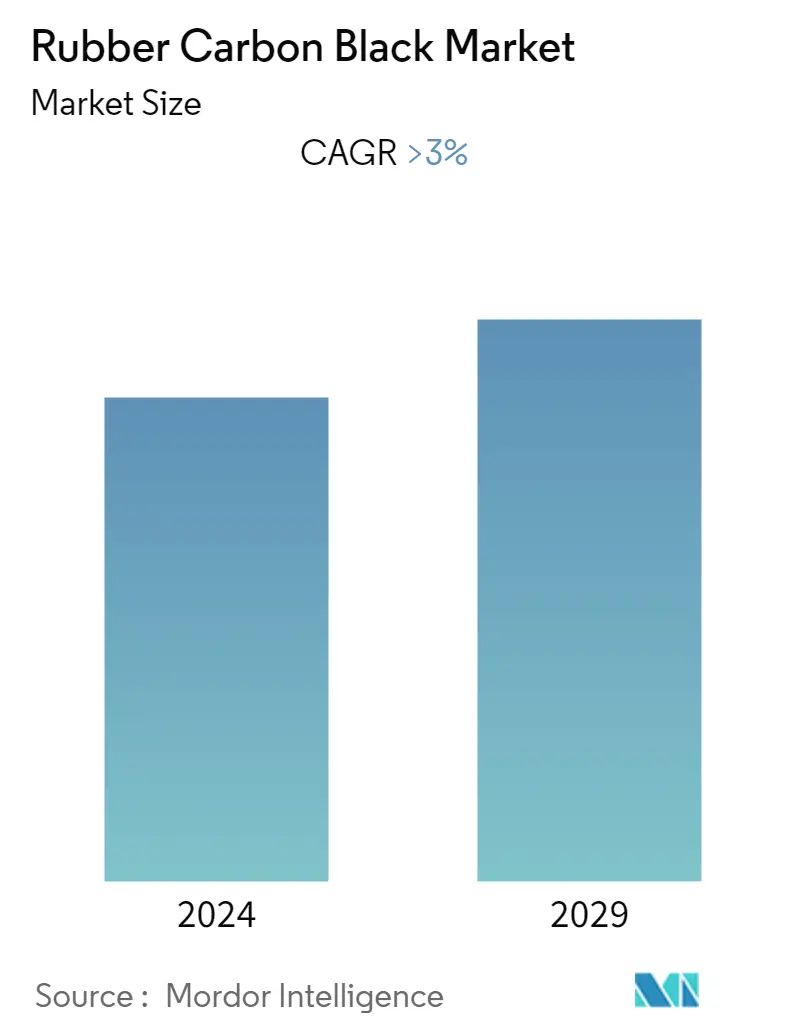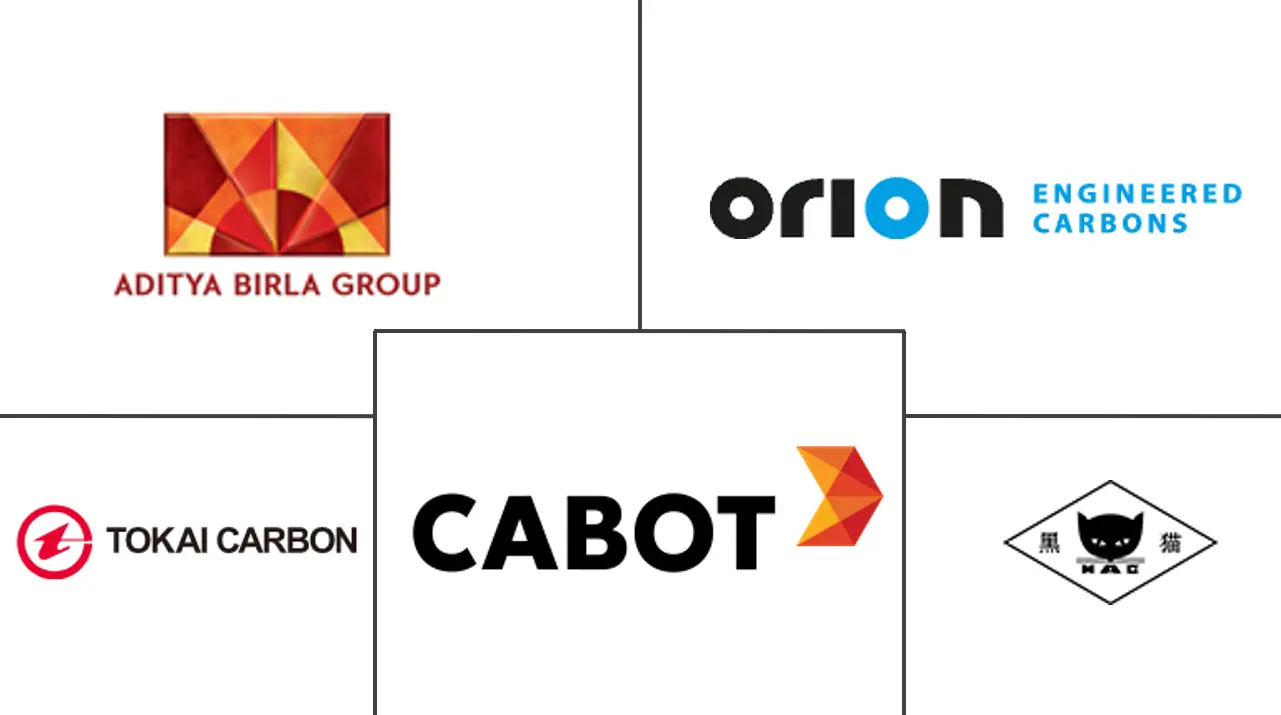Market Size of Rubber Carbon Black Industry

| Study Period | 2019 - 2029 |
| Base Year For Estimation | 2023 |
| CAGR | 3.00 % |
| Fastest Growing Market | Asia-Pacific |
| Largest Market | Asia-Pacific |
| Market Concentration | High |
Major Players
*Disclaimer: Major Players sorted in no particular order |
Rubber Carbon Black Market Analysis
The Global Rubber Carbon Black Market was valued at 10,701.4 kilo tons in 2021 and is projected to register a CAGR of around 3% during the forecast period (2022-2027).
Carbon black is an elemental carbon in the form of extremely fine particles having an amorphous molecular structure. Other than carbon, carbon black also contains small quantities of other elements such as oxygen, hydrogen, and sulfur. Rubber grade carbon black is mainly used in tires to increase the durability and strength of the tire and also darkens the color of the tire. Rubber grade carbon black also finds applications in mechanical rubber goods such as hoses, belts, gaskets, vibration control, and footwear.
- Over the short term, the increasing demand for automotive tires and the increasing demand for carbon black for industrial rubber applications are some driving factors stimulating the market demand.
- Fluctuation in prices of oil-derived feedstocks used for black carbon manufacturing, increasing use of green tires, and growing environmental concerns regarding harmful particulate matter emissions while producing carbon black are hindering the market's growth.
- Increasing the use of recycled and bio-based carbon black will likely create opportunities for the market in the coming years.
- The Asia-Pacific region is expected to dominate the market and will also witness the highest CAGR during the forecast period.
Rubber Carbon Black Industry Segmentation
The rubber carbon market is segmented by Application and Geography. By Application, the market is segmented into Tires, Hoses, Belts, Gaskets, Vibration Control, and Footwear. The report also covers the market size and forecasts for the rubber carbon black market in 18 countries across major regions. For each segment, the market sizing and forecasts have been done based on volume (kilo tons).
| Application | |
| Tires | |
| Hoses | |
| Belts | |
| Gaskets | |
| Vibration Control | |
| Footwear |
| Geography | ||||||||||
| ||||||||||
| ||||||||||
| ||||||||||
| ||||||||||
|
Rubber Carbon Black Market Size Summary
The rubber carbon black market is poised for steady growth, driven primarily by the increasing demand for automotive tires and industrial rubber applications. Carbon black, an elemental carbon in fine particle form, is essential for enhancing the durability and strength of tires, as well as for its application in various mechanical rubber goods. Despite challenges such as fluctuating oil-derived feedstock prices and environmental concerns over emissions, the market is expected to benefit from the rising use of recycled and bio-based carbon black. The Asia-Pacific region, particularly China and India, is anticipated to lead the market due to their robust automotive production and expanding tire industries.
The market landscape is characterized by a consolidated structure with key players like Cabot Corporation, Birla Carbon, and Orion Engineered Carbons GmbH. Recent developments include new production facilities and capacity expansions aimed at meeting the growing demand for specialty and high-end rubber grades. The Asia-Pacific region's dominance is further supported by China's significant contribution to global carbon black production and India's expanding tire market. These factors collectively underscore the market's potential for growth, with strategic investments and innovations playing a crucial role in shaping its future trajectory.
Rubber Carbon Black Market Size - Table of Contents
-
1. MARKET DYNAMICS
-
1.1 Drivers
-
1.1.1 Increasing Demand for Automotive Tires
-
1.1.2 Increasing Demand for Carbon Black in Industrial Rubber Applications
-
-
1.2 Restraints
-
1.2.1 Fluctuation In Prices of Oil Derived Feedstocks Used for Carbon Black Manufacturing
-
1.2.2 Increasing Use of Green Tires
-
1.2.3 Growing Environmental Concerns Regarding Emissions of Harmful Particulate Matter During The Production Of Carbon Black
-
-
1.3 Industry Value-Chain Analysis
-
1.4 Porter's Five Forces Analysis
-
1.4.1 Bargaining Power of Suppliers
-
1.4.2 Bargaining Power of Buyers
-
1.4.3 Threat of New Entrants
-
1.4.4 Threat of Substitute Products and Services
-
1.4.5 Degree of Competition
-
-
-
2. MARKET SEGMENTATION
-
2.1 Application
-
2.1.1 Tires
-
2.1.2 Hoses
-
2.1.3 Belts
-
2.1.4 Gaskets
-
2.1.5 Vibration Control
-
2.1.6 Footwear
-
-
2.2 Geography
-
2.2.1 Asia-Pacific
-
2.2.1.1 China
-
2.2.1.2 India
-
2.2.1.3 Japan
-
2.2.1.4 South Korea
-
2.2.1.5 Rest of Asia-Pacific
-
-
2.2.2 North America
-
2.2.2.1 United States
-
2.2.2.2 Canada
-
2.2.2.3 Mexico
-
-
2.2.3 Europe
-
2.2.3.1 Germany
-
2.2.3.2 United Kingdom
-
2.2.3.3 Italy
-
2.2.3.4 Russia
-
2.2.3.5 France
-
2.2.3.6 Spain
-
2.2.3.7 Turkey
-
2.2.3.8 Rest of Europe
-
-
2.2.4 South America
-
2.2.4.1 Brazil
-
2.2.4.2 Argentina
-
2.2.4.3 Rest of South America
-
-
2.2.5 Middle East and Africa
-
2.2.5.1 Saudi Arabia
-
2.2.5.2 South Africa
-
2.2.5.3 Rest of Middle East and Africa
-
-
-
Rubber Carbon Black Market Size FAQs
What is the current Rubber Carbon Black Market size?
The Rubber Carbon Black Market is projected to register a CAGR of greater than 3% during the forecast period (2024-2029)
Who are the key players in Rubber Carbon Black Market?
Cabot Corporation , Aditya Birla Group , Orion Engineered Carbons GmbH, Jiangxi Black Cat Carbon Black Co., Ltd. and Tokai Carbon Co. Ltd are the major companies operating in the Rubber Carbon Black Market.

